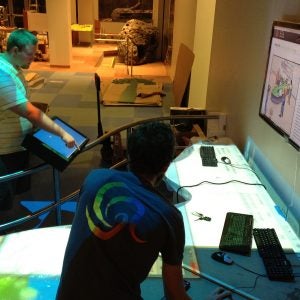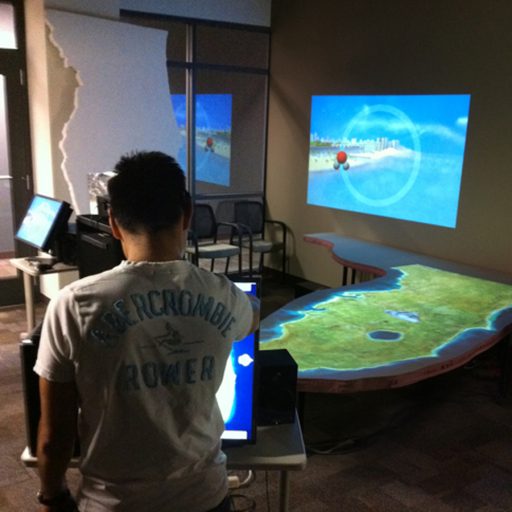
Visitors to a Fort Lauderdale science museum soon will interact with 92 prehistoric animals and fish. They’ll also have a chance to manipulate a 10-foot-by-10-foot map of Florida that shows how climate change could impact the state’s water supply. And that’s just for starters.
Developed in a University of Central Florida simulation lab, the exhibits are part of the Museum of Discovery and Science’s new 34,000 – square-foot EcoDiscovery Center, which aims to show visitors the global impact of climate change, the promise of alternative energy sources and the vital role of the Everglades in safeguarding Florida’s fragile water supply.
The exhibit, which is being installed this month, will open Nov. 5 with a gala for museum patrons and the following weekend to the general public.
Funded with a $2.9 million National Science Foundation grant, the project is four years in the making and a dream fulfilled for Eileen Smith, director of the E2i Creative Studio at UCF’s Institute for Simulation and Training.
“This is why I came to UCF,” Smith said of creating interactive elements for museums. “We can do so much to help families learn about science and math in fun ways at a museum, and technology can be a great tool to connect learners with each other and the topic. They don’t even realize at first that they are learning.”
The museum, which draws crowds of 450,000 annually, expects the new wing to be a huge hit. The primary target audience is adolescent learners, and the researchers will evaluate how well the exhibit connects with the teenagers and their families.
“They are the gatekeepers for families,” Smith said. “They are the ones that often introduce and familiarize family members with new technology, so we focused on making the exhibits attractive to them. Then the whole family benefits.”
In addition to the UCF-created exhibits, there is a simulated Everglades airboat ride with special effects, a storm center, a hall of science, several new laboratory classrooms and a water area for children.
The UCF team included researchers from E2i Creative as well as UCF alumni, faculty members and graduate and undergraduate students from disciplines as diverse as Digital Media, Modeling and Simulation, Computer Science, Biology and Statistics.
The team spent two years designing the exhibits and another two years producing the rich dynamic media for learners to explore.
The team conducted research into past, present and future Florida, and then built 10 exploration stations. The Prehistoric Florida stations simulate the exploration of 92 animals and fish from Florida’s past, and those stations are co-located with several physical specimens, including a Megaladon that was 75 feet long when it prowled the waters of Florida. Each of the learning stations tells a story; among the topics discussed are how forest fires impact the Everglades, how the hydrologic cycle works and how foreign species are impacting native species.
One of the most interesting pieces is the horizontal model of the State of Florida. This Florida Table enables visitors to manipulate the hydrologic cycle, the wet and dry seasons and explore how they all affect the water available in Florida.
“The most exciting aspect so far has been collaborating with an immensely diverse team, including undergraduate students, leading scientists, national design firms, educators, evaluators and museum teams, all of which have a unique perspective,” said Michael Carney, the production manager for the project. Carney began working on it when he was an undergraduate at UCF, and today he mentors students as experience producer at E2i Creative.
Smith and many of her team members helped to create a popular interactive simulation exhibit at the Orlando Science Center in 2005. Realistic prehistoric sea creatures were brought to life in the exhibit hall through the use of a glass dome. It was one of the most popular exhibits in the DinoDigs Hall during its monthlong test.
The group’s mission is to “melt the boundaries between reality and imagination by creating compelling interactive, simulated experiences that spark the imagination, enlighten the mind and immerse the body and spirit.”
